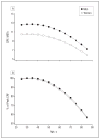Role of lifestyle and aging on the longitudinal change in cardiorespiratory fitness
- PMID: 19858436
- PMCID: PMC3379873
- DOI: 10.1001/archinternmed.2009.312
Role of lifestyle and aging on the longitudinal change in cardiorespiratory fitness
Abstract
Background: Cardiorespiratory fitness (CRF) in adults decreases with age and is influenced by lifestyle. Low CRF is associated with risk of diseases and the ability of older persons to function independently. We defined the longitudinal rate of CRF decline with aging and the association of aging and lifestyle with CRF.
Methods: We studied a cohort of 3429 women and 16 889 men, aged 20 to 96 years, from the Aerobics Center Longitudinal Study who completed 2 to 33 health examinations from 1974 to 2006. The lifestyle variables were body mass index, self-reported aerobic exercise, and smoking behavior. Cardiorespiratory fitness was measured by a maximal Balke treadmill exercise test.
Results: Linear mixed models regression analysis stratified by sex showed that the decline in CRF with age was not linear. After 45 years of age, CRF declined at an accelerated rate. For each unit of increase in body mass index, the CRF of women declined 0.20 metabolic equivalents (METs) (95% confidence interval, -0.21 to -0.19); that of men, 0.32 METs (-0.33 to -0.20). Current smokers of both sexes also had lower CRF (-0.29 METs [95% confidence interval, -0.40 to -0.19] for women and -0.41 METS [-0.44 to -0.38] for men). Cardiorespiratory fitness was positively associated with self-reported physical activity.
Conclusions: Cardiorespiratory fitness in men and women declines at a nonlinear rate that accelerates after 45 years of age. Maintaining a low BMI, being physically active, and not smoking are associated with higher CRF across the adult life span.
Figures


References
-
- Lurie N. Healthy People 2010: setting the nation’s public health agenda. Acad Med. 2000;75(1):12–13. - PubMed
-
- Ogden CL, Carroll MD, Curtin LR, McDowell MA, Tabak CJ, Flegal KM. Prevalence of overweight and obesity in the United States, 1999–2004. JAMA. 2006;295(13):1549–1555. - PubMed
-
- Rosamond W, Flegal K, Friday G, et al. American Heart Association Statistics Committee and Stroke Statistics Subcommittee. Heart disease and stroke statistics—2007 update: a report from the American Heart Association Statistics Committee and Stroke Statistics Subcommittee [published correction appears in Circulation. 2007;115(5):e172] Circulation. 2007;115(5):e69–e171. doi: 10.1161/CIRCULATIONAHA.106.179918. - DOI - PubMed
-
- Fleg JL, Morrell CH, Bos AG, et al. Accelerated longitudinal decline of aerobic capacity in healthy older adults. Circulation. 2005;112(5):674–682. - PubMed
-
- Barlow CE, LaMonte MJ, FitzGerald SJ, Kampert JB, Perrin JL, Blair SN. Cardiorespiratory fitness is an independent predictor of hypertension incidence among initially normotensive healthy women. Am J Epidemiol. 2006;163(2):142–150. - PubMed

